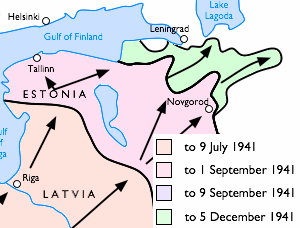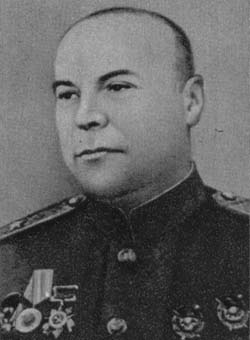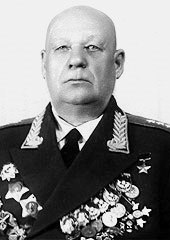Related Research Articles

The Battle of Narva Bridgehead was the campaign that stalled the Soviet Estonian operation in the surroundings of the town of Narva for six months. It was the first phase of the Battle of Narva campaign fought at the Eastern Front during World War II, the second phase being the Battle of Tannenberg Line.

The Battle of Narva was a World War II military campaign, lasting from 2 February to 10 August 1944, in which the German Army Detachment "Narwa" and the Soviet Leningrad Front fought for possession of the strategically important Narva Isthmus.

Konstantin Apollonovich Koroteyev was a Soviet Army colonel general and a Hero of the Soviet Union.
The 8th Army was a field army of the Soviet Red Army during the Second World War.
The Baltic strategic defensive operation encompassed the operations of the Red Army from 22 June to 9 July 1941 conducted over the territories of the occupied Lithuania, Latvia, and Estonia in response to the offensive launched by the Wehrmacht in Operation Barbarossa.
The 14th Rifle Division was an infantry division of the Red Army. Formed in Moscow in 1922, the division spent most of the interwar period at Vladimir. After moving to the Kola Peninsula during the Winter War, the division fought on that front during the Continuation War. After the end of the Continuation War it became the 101st Guards Rifle Division.
The 21st Rifle Division was an infantry division of the Russian Soviet Federative Socialist Republic and then the Soviet Union's Red Army, active between 1918 and 1945.

Leningrad strategic defensive operation is the term in Soviet historiography for the defensive operations in the area south of Leningrad by the Red Army and the Soviet Navy during World War II from 10 July to 30 September 1941. The following operations are considered as part of the strategic operation:

Stepan Ilyich Oborin was a Red Army major general. Oborin served as a gunner in the Imperial Russian Army in World War I and subsequently joined the Red Army. He fought in the Russian Civil War and became an artillery officer. He led the artillery of the 19th Rifle Corps in the Winter War. After the end of the war, he became commander of the 136th Rifle Division and then the 14th Mechanized Corps. The corps was destroyed in the Battle of Białystok–Minsk after the German invasion of the Soviet Union. Oborin was wounded during the battle and flew back to Moscow for treatment. He was arrested for desertion, sentenced to death, and shot on 16 October 1941. Oborin was posthumously rehabilitated in 1957.
The 33rd Kuban Rifle Division was an infantry division of the Red Army during the Russian Civil War and the Polish–Soviet War. The division was first formed as the 33rd Rifle Division in March 1919 on the Southern Front and became the 33rd Kuban Rifle Division in December 1919. From June 1920 the division fought in the Polish–Soviet War. In September 1920, the units from the 33rd and other divisions became part of the new Kuban Cavalry Division, which soon became the 5th Kuban Cavalry Division.
The 275th Rifle Division was an infantry division of the Soviet Union's Red Army during World War II, formed twice.
The 263rd Rifle Division was an infantry division of the Red Army during World War II.
The 262nd Rifle Division was an infantry division of the Red Army during World War II.

The Kharkov Military District was a military district of the Russian Empire, the Russian Soviet Federative Socialist Republic, and the Soviet Union. Throughout its history, the district headquarters was located in the city of Kharkov in northeastern Ukraine.
The 57th Red Banner Ural-Khingan Rifle Division was an infantry division of the Red Army and the Soviet Army.

Trofim Ivanovich Tanaschishin was a Red Army lieutenant general killed during World War II.

Mikhail Stepanovich Shumilov was a Soviet Colonel general and commander of the 64th Army during the Battle of Stalingrad. There he defended the southern outskirts of the city and the bridgehead of Beketovka on the Volga for more than six months.
The 121st Rifle Division was an infantry division of the Red Army during World War II.

Mikhail Borisovich Anashkin was a Red Army lieutenant general and a Hero of the Soviet Union.

Ivan Stepanovich Kosobutsky was a Soviet Army lieutenant general who held corps command during World War II.
References
Citations
- 1 2 Cherushev & Cherushev 2012, pp. 187–188.
- 1 2 3 4 Dvoinykh, Kariaeva, Stegantsev, eds. 1993, p. 25.
- 1 2 Cherushev & Cherushev 2012, pp. 106–107.
- 1 2 Cherushev & Cherushev 2012, pp. 82–83.
- 1 2 Cherushev & Cherushev 2012, pp. 250–251.
- 1 2 3 Vozhakin 2005, pp. 272–273.
- ↑ Meltyukhov 2001, p. 299.
- ↑ Meltyukhov 2001, p. 350.
- ↑ Glantz 1998, p. 262.
- 1 2 3 4 5 6 7 8 9 10 Gladysh & Milovanov 1994.
- 1 2 3 Main Personnel Directorate of the Ministry of Defense of the Soviet Union 1964, p. 11.
- ↑ Vozhakin 2006, p. 482.
- ↑ Vozhakin 2006, p. 194.
- ↑ Vozhakin 2006, p. 213.
- ↑ Vozhakin 2006, p. 142.
- ↑ Vozhakin 2006, p. 215.
- ↑ Feskov et al 2013, pp. 407–408.
Bibliography
- Cherushev, Nikolai Semyonovich; Cherushev, Yury Nikolaevich (2012). Расстрелянная элита РККА (командармы 1-го и 2-го рангов, комкоры, комдивы и им равные): 1937—1941. Биографический словарь[Executed Elite of the Red Army (Komandarms of the 1st and 2nd ranks, Komkors, Komdivs, and equivalents) 1937–1941 Biographical Dictionary] (in Russian). Moscow: Kuchkovo Pole. ISBN 9785995002178.
- Dvoinykh, L.V.; Kariaeva, T.F.; Stegantsev, M.V., eds. (1993). Центральный государственный архив Советской армии [Central State Archive of the Soviet Army] (in Russian). Vol. 2. Minneapolis: Eastview Publications. ISBN 1-879944-03-0. Archived from the original on 2016-12-03. Retrieved 2017-12-22.
- Feskov, V.I.; Golikov, V.I.; Kalashnikov, K.A.; Slugin, S.A. (2013). Вооруженные силы СССР после Второй Мировой войны: от Красной Армии к Советской [The Armed Forces of the USSR after World War II: From the Red Army to the Soviet: Part 1 Land Forces] (in Russian). Tomsk: Scientific and Technical Literature Publishing. ISBN 9785895035306.
- Gladysh, Sergey; Milovanov, V.I. (1994). Восьмая общевойсковая: боевой путь 8-й армии в годы Великой Отечественной войны [Eighth Combined Arms: The 8th Army's Combat Path in the Great Patriotic War] (in Russian). Moscow: Institute of Military History of the Ministry of Defense of the Russian Federation. ISBN 9785747400016.
- Glantz, David M. (1998). Stumbling Colossus: The Red Army on the Eve of World War. Lawrence: University Press of Kansas. ISBN 0-7006-0879-6.
- Main Personnel Directorate of the Ministry of Defense of the Soviet Union (1964). Командование корпусного и дивизионного звена советских вооруженных сил периода Великой Отечественной войны 1941–1945 гг [Commanders of Corps and Divisions in the Great Patriotic War, 1941–1945] (in Russian). Moscow: Frunze Military Academy.
- Meltyukhov, Mikhail (2001). Советско-польские войны. Военно-политическое противостояние 1918-1939 гг [Soviet–Polish War: Military and Political Confrontation 1918–1939] (in Russian). Moscow: Veche. ISBN 9785783809514.
- Vozhakin, Mikhail Georgievich, ed. (2005). Великая Отечественная. Командармы. Военный биографический словарь[The Great Patriotic War: Army Commanders: Military Biographical Dictionary] (in Russian). Moscow: Kuchkovo Pole. ISBN 5860901135.
- Vozhakin, M.G., ed. (2006). Великая Отечественная. Комкоры. Военный биографический словарь [The Great Patriotic War: Corps Commanders: Military Biographical Dictionary] (in Russian). Vol. 1. Moscow: Kuchkovo Pole. ISBN 5-901679-11-3.